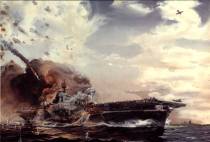|
Lt.
Cecil E. Harris

Like Joe Foss, here was another Pacific ace from the inland state of
South Dakota. Born in 1916, he was attending Northern State Teachers'
College when WWII started. He joined the Navy before Pearl Harbour, and was
appointed an aviation cadet. He trained at Minneapolis and Corpus Christi,
and in April 1942 became part of VGF-27, followed by more training.
VGF-27, on board the escort carrier Suwanee CVE-27, took part in
the Operation
Torch landings in North Africa. In early 1943, Suwanee sailed
to the southwest Pacific to support operations in the Solomons. Because
the escort carrier was so small, her Wildcat-equipped fighter squadron was
detached to operate from land, and was re-designated VF-27. Harris served
here, shooting down two Japanese planes.

Later, he flew F6F Hellcats for VF-18, based on the carrier USS Intrepid, CV-11.
He downed 3 Hamps and a Zero on Sept. 13, 1944.
On October 12, 1944, he embarked on a memorable mission, the
war's first air strike at Jap airfields on Formosa, in preparation for the
liberation of the Philippines. Following the invasion of the Marianas in
June-August, under Admiral Nimitz, and General MacArthur's drive from New
Guinea to the south, the Americans were ready to make good on the
General's famous pledge "I shall return."
On the 12th, the Fast Carrier Task Force began three days of strikes
against the large Japanese air forces on Formosa. VF-18 flew cover for the
torpedo squadron, VT-18, and the dive-bombing squadron, VB-18. Harris was
one of 16 pilots from VF-18 participating in the day's fighter sweep,
launched before dawn in order to catch the enemy aircraft on the ground at
first light.
VF-18 flew northwest from the Intrepid, to hit an airfield on
the north-eastern corner of Formosa, as squadron CO Lt. Cdr. Ed Murphy had
briefed them the previous night. On schedule, all the Hellcats catapulted
off the carrier, and began the slow climb to altitude. Murphy's own
division of four planes was in the lead, the second division behind and to
his right. Behind the second division, and well to the left was Harris'
third division. The fourth division flew behind and to the left of Harris;
all climbing at 150 knots. Many other planes from Task Force 38 carriers
accompanied VF-18. All maintained radio silence, as they levelled off at
15,000 feet.
As they approached Formosa, they pointed their noses downward and began
to gain speed. When Harris, his wingman Burley, and Lt. Bill Zeimer's
section approached the field, five enemy bombers had just taken off from
the field. In a few seconds Zeimer's gunfire tore into and exploded the
first bomber. Harris soon added one of his own. They turned and both
quickly splashed another bomber each. Easy so far, but Zeroes appeared up
above, dove down and shot up Zeimer's plane. His chute opened and Zeimer
floated down. His wingman, DiBatista, locked onto the Zero and avenged
Zeimer's loss. Another Zero dived onto DiBatista, and hit him with 20mm
cannon fire. But in the deadly round-robin of aerial combat, Harris got
behind this Zero and his concentrated 50 calibre fire took a heavy toll.
The Zero crashed into the trees and blew up, for Harris' third victory of
the day.
While escorting the DiBatista's damaged plane back to Intrepid,
he downed another Zero, his fourth of the day.
He followed this up by shooting down three Judys on the 14th. His
mission on the 29th earned him a Navy Cross. Over Luzon, he intercepted
two flights of Japanese fighters that were preparing to hit American
bombers and torpedo planes. He led his division to the attack, downing
four and disrupting the remainder. Harris accumulated a total of 24
victories against the Japanese (the second highest scoring US Navy
ace). He was out of action from November, 1944, when the Intrepid
was badly damaged in a kamikaze attack. He earned the Navy Cross, the DFC,
a Silver Star, and two Gold Stars.
After the war, he resumed his teaching career in South Dakota.
He committed suicide while in police custody on his birthday in
Washington, DC; depression and alcohol having played their parts. It's far
more important to remember what he did for his country rather that how he
died.
|
